Mediterranean Climate
by Devender
0 2005
This climate is found between the 30° - 45° North-South latitudes. It gets its name from the climate around the Mediterranean Sea and this type of climate is basically caused by the shifting of the wind belts with summers and winters. In the summers, it is warm to hot while in winters, it is cool but mild.
Mediterranean Climate
These regions are also known as "Winter-rain and summer dry". The Mediterranean habitat can be divided into 5 subtypes in accordance to the various floristic realms into which each fall –
| Mediterranean | Areas around Mediterranean sea |
| Californian | Around San Francisco |
| Chilean | Central Chile (South America) |
| Capensic | Cape Town, Africa |
| Australian | Southern & Western Australia |
This type of agriculture is greatly present in the areas around the Mediterranean Sea; however, this type of climate is best developed in Central Chile. The strong and cold up-welling currents provide cool marine air and moderate winter temperatures in the coastal regions except for the Mediterranean basin and South and Western Australia.
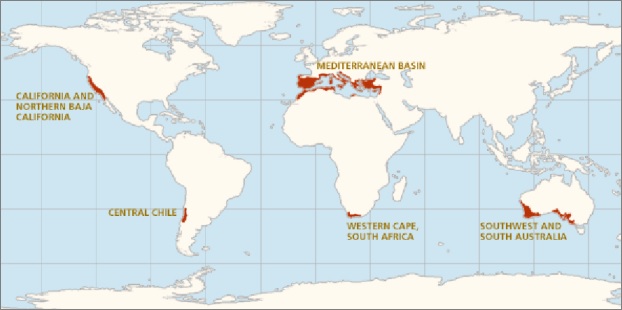
1 Dry, warm summer with offshore trade winds:
Relatively higher temperatures around 20 to 30 Degree C are noticed in the summer months while the highest temperature recorded is away from the coast and in the more eastern continental Mediterranean. The belt of influence of westerlies gets shifted a little towards poles in summers when the sun is overhead at the Tropic of Cancer.
- Therefore, the rain-bearing winds are not likely to reach Mediterranean lands
- The prevailing trade winds are off-shore
- Therefore, the air is dry, heated, and is of low relative humidity
- There are practically no rains
- The days are excessively warm in the interiors
- Prolonged droughts are very common
- The moderating effects of the seas provide relief to the areas at the coast
- The mean annual rainfall is approximately 70 cm
- It differs greatly from place to place
- It depends on the relief, continentality, and passing of the cyclones
- Mountains back the Mediterranean region along the coasts
- It provides an effective barrier to oncoming westerlies
- The rain comes in heavy showers but only for a few days
- There are bright sunny periods between the showers
- It mostly happens from the month of Sep to Feb with a peak in October
- The rain is infrequent but still, they are very torrential
- In mountain ranges, these rainfalls cause destructive floods
- Local Winds around the Mediterranean Sea:
- This wind originates in the Sahara desert
- It is hot, dry, and dusty in nature
- This wind may occur at any time of the year
- But are most common in the springs
- It lasts for only a few days
- The Fohn wind is experienced in the valleys of the northern Alps
- It is particular in spring in Switzerland
- The Chinook winds are experienced in winters on the eastern slopes of the Rockies in the USA and Canada
- The wind loses most of its moisture while descending
- Therefore, it becomes hot and dry leading to rising in temperature of the leeward side
- The Mistral is most frequent in the winters
- The temperature of the wind at this time might be below the freezing point
- Though, the sky might be clear and cloudless
- It is a cold north-easterly wind
- It is experienced along the Adriatic coast
- It is caused by a difference in pressure between the Mediterranean and continental Europe
- The strong boras have a tendency to ruin agricultural lands
- It also blows ships aground
- The natural vegetation of the Mediterranean Region:
- The trees are never very tall and have small broad leaves
- The Mediterranean lands have a distinct feature of the absence of shade
- The soil has rich iron content and is often reddish in colour
- There is only a little leaching of soil because of low amounts of rainfall
- Lack of leaf fall results in low humus content of the soil
- They have deeply fissured barks with small leathery leaves
- The roots are widespread to search for water
- It includes various kinds of pines, cedars and cypresses with needle-shaped leaves
- They have tall and straight trunks
- Appear more on the cooler highlands and where droughts are not much severe
- These bushes and shrubs are scattered in clamps & are often thorny
- These are generally drought and heat resistant
- They have developed various strategies for the growth and use of available water during the dry period
- They are usually known by different names at different places such as:
- Therefore, the grass even if survives will be wiry and bunchy
- It will not be suitable for animal farming
- So, cattle rearing is not an important feature of this region
- Agricultural Development in the Mediterranean:
- The citrus fruits have thick leathery skins
- It prevents excessive transpiration
- The long, sunny summer enables the fruit to be ripened and harvested
- 70 % of the world's export of citrus fruit is accounted from the Mediterranean area
- The most typical of all the Mediterranean cultivated vegetation is the olive tree
- The farmers usually sow the seeds in autumn
- The seeds can grow and germinate steadily with the coming winter rain
- There is enough moisture for wheat to mature by springs
- The long, sunny summer enables grapes to ripen
- 85% of the total grapes go-to wine production
Except for large portions of the Mediterranean basin, the entire Mediterranean region lies on the western margin of the continents, and all the regions are situated along the coast of oceans or the Mediterranean Sea.
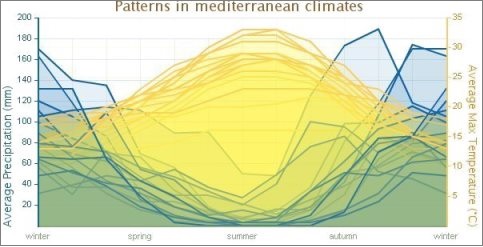
2 Mild, Rainy winter with onshore Westerlies:
Most of the precipitation (around 65-70%) received by the Mediterranean lands is received in the winters when the westerlies shift towards the equator. The average temperature in winters is approximately 10 to 12 Degree C. The prevailing winds onshore in the northern hemisphere are westerlies which bring cyclonic rain from the Atlantic to the countries bordering the Mediterranean Sea.
Due to this, the Portuguese coast is much wetter than in eastern Spain. The highlands of the windward slopes facing the westerlies receive much heavier precipitation. The rainiest parts of Europe are the steep hills of the eastern Adriatic.
Due to the varied topography of the region, many local winds are very common around the Mediterranean Sea. These winds are some of the hot types while other being cold. There are great differences in temperature, atmosphere, and precipitation because of High Alps in the north, Sahara desert in the south, Continental interiors in the east, and open Atlantic on the west.
The relief features often interrupt the passing cyclones from the Atlantic, the anti-cyclones from the north, and the cold air masses from the continental interior. It finally results in the birth of local winds around the Mediterranean. These different winds are –
1 Sirocco Wind
It blows outward from the desert interior to the cooler Mediterranean Sea and is usually associated with the depressions from the Atlantic passing from the coast to eastward inland. It gets slightly cool by the adsorption of water vapour from the Mediterranean Sea. However, it still remains hot and dry with a temperature around 40* C.
Sirocco wind has a tendency to wither the crops and vegetation. When it comes during the time of blossom of Vines and Olives, the damage is very serious. These winds are also known as blood rain because of the red dust it carries from the Sahara desert. It is known with many names in different places which explain its prominence. These names are:
| Chili | Tunisia |
| Ghibli | Libya |
| Leveche | Spain |
| Khamsin | Egypt and Malta |
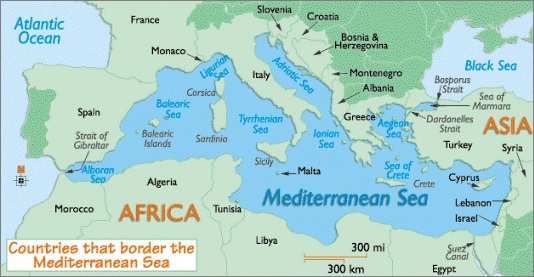
This wind also causes fog, dew, and rains. This hot wind known as Gharbi collects a lot of moisture when it passes the Adriatic & Aegean Sea.
2 Fohn Wind & Chinook Wind
Both these winds are local hot and dry winds and are experienced on the leeward side of the mountains when the descending air becomes compressed with the increased pressure.
These winds are called the Chinook which means snow eater as it melts down the snow and also causes avalanches. It also enhances the growth of crops and fruits. It also raises the temperature of the region quite quickly thawing the snow-covered pastures.
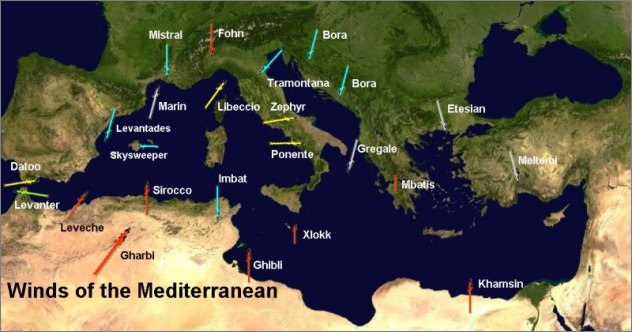
3 Mistral Wind
The Mistral wind is a cold wind front from the north. It rushes down with violent speeds between 40 to 80 miles/hour to the Rhone valley (France). The velocity of it gets intensified by the funnelling effect between the Alps and Central Massif (France).
So, there are thick rows of trees and hedges around the houses & Orchards of Rhone valley & Riviera that are planted with an objective to shield from the Mistral.
4 Bora Wind
It usually occurs in the winters when the atmospheric pressure over continental Europe is much more than in the Mediterranean. This wind is much more violent in nature than the Mistral with speeds over 100 mph.
The luxuriant natural vegetation is not possible in a land with half the year dry, so, it is xerophyte or drought-resistant. It consists of cypress, cork oak, scrub evergreen, olives, and low bushes. The vegetation of this climate must be adaptive to survive the hot, long summer droughts and long wet period in winters.
The growth is slow in the winter and summer seasons due to more rainfall in winters and long drought in summer. Therefore, the growth only occurs in the autumn and spring season when the temperature is high and moisture is just enough for growth.
1 Mediterranean Evergreen Forests:
The open woodlands with evergreen oaks are found in the regions having rainfall much over 70 cm such as Spain and Portugal. Eucalyptus forests replace the evergreen oaks in Australia where the trees are normally low with massive trunks.
2 Evergreen Coniferous Trees:
3 Bushes & Shrubs:
Bushes and Shrubs are the most dominant type of Mediterranean vegetation because the summers are so hot and dry which leads to forests giving birth to short and evergreen Bushes and Shrubs.
| Maquis | Mediterranean |
| Chaparral | California |
| Matorral | Chile |
| Fynbos | South Africa |
| Mallee and kwongan | Australia |
4 Grass:
The conditions in the Mediterranean don't suit grass as much of the rain comes in the winters when the growth rate is minimal. The slow-growing vegetation that cannot replenish its foliage readily and doesn't have deep roots is not much suitable in this region.
The grass gets replaced with certain drought-resistant varieties of shrubs and flowering herbs. These can support sheep or goats. The animal’s fats are not important in the region and hence, chief cooking oil comes from olives. These regions import various dairy products.
The Mediterranean lands are majorly famous for citrus fruit cultivation, Winemaking, and Cereal growing.
1 Orchard Farming:
The Mediterranean lands are also known as the world's orchard lands and wide varieties of citrus fruits are grown here such as Oranges, limes, lemons, citrons, and grapefruit. The fruit trees have long roots to draw water from depths during the long drought season in summer. In extremely dry areas, the lack of moisture is relieved with the help of irrigation.
The olive trees are so hard and long-rooted that they can survive even on the poorest limestone soil having an average annual rainfall of less than 25 cm. Many nut trees such as chestnuts, walnuts, hazelnuts, and almonds are grown here besides olives. They are picked as fruits or for the chocolate industry. Peaches, apricots, pears, plums, figs, and cherries are other important fruits.
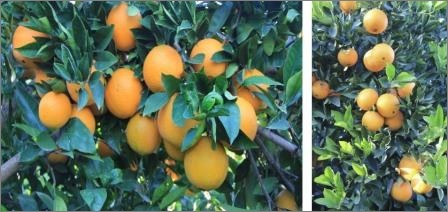
2 Crop Cultivation:
The most important cultivated crops in the Mediterranean are Cereals and Wheat is the leading food crop. It is used for bread making. The next important cereal would be barley followed by other food products such as spaghetti, vermicelli, and macaroni.
The other important food crops cultivated in this region are rice, vegetables especially beans, and flowers for the local market. A little cotton and Tobacco are also grown in this part. Fur sheep, goats, and sometimes cattle with the widespread practice of transhumance are supported by the mountain pastures with a cool climate.
3 Wine Cultivation:
Wine cultivation is a speciality of the Mediterranean countries and the regions bordering the Mediterranean Sea account for around 3/4th of the total world’s wine production.

Share:







Comments
Waiting for your comments